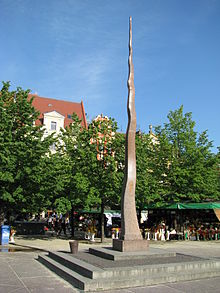Salt Market (Wroclaw)

The Salt Market (Polish: Plac Solny , 1827–1945: Blücherplatz ) is a square in the old town of Wroclaw . It borders the southwest corner of the Great Ring .
history
In the Middle Ages, salt was traded on this square, hence the name. The first mention of the place goes back to the year 1242; at that time there was talk of a Polish market or a salt square. Between 1827 and 1945 the place was called Blücherplatz after the Prussian field marshal Gebhard Leberecht von Blücher . In his honor, the Blücherdenkmal was built in the middle in 1827 , which was destroyed in 1945. In World War II, most of the houses were destroyed or severely damaged. Most of them were rebuilt by 1961, with some of the facades and the number of floors being changed. At the end of the 20th century, a sculpture of a needle was placed in the middle of the square.
Today the flower market is located on the square. There are numerous restaurants and cafés in the surrounding houses.
Development on the salt market
At the northeast corner, the square borders the Great Ring . The large bank, built in the 1930s and used today by Bank Zachodni, is located here. The building right next to it dates from the 1920s and was built by Adolf Rading in the functionalist modern style (No. 3). The Oppenheim House (OP ENHEIM Dom dla Kultury), directly adjacent to the west (No. 4), dates from the middle of the 18th century. The baroque house with the green facade survived the Second World War unscathed. A jewelry store and a café can be found on the ground floor.
The western side of the salt market begins with house number 6. In the seven-story building there is an arcade with cross vaults. The gable of the house extends over four floors. The classicistic old stock exchange is located on the south side of the square .
On the east side, at the southern end, at the intersection of ul. Geperta (formerly Schloßstraße) and ul. Ofiar Oświęcimskich (formerly Junkernstraße), the Rybisch Palace, built between 1522 and 1531, dominates. The facade design, formerly in the style of the Renaissance, can only be seen today on the ground floor of the building. The Polish painter Eugeniusz Geppert lived in the house between 1946 and 1979 .
Web links
literature
- Klaus Klöppel: Breslau - Lower Silesia and its millennial capital. Trescher Verlag, Berlin 2014, ISBN 978-3-89794-256-1 , pp. 59-60
Coordinates: 51 ° 6 ′ 33.9 ″ N , 17 ° 1 ′ 46.5 ″ E


